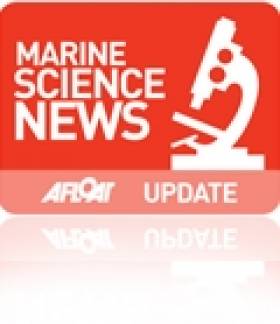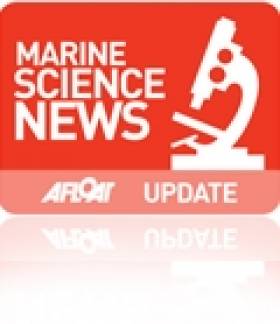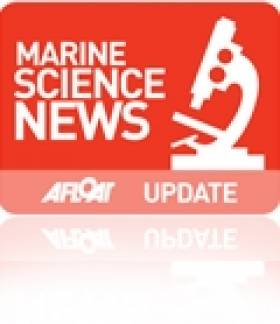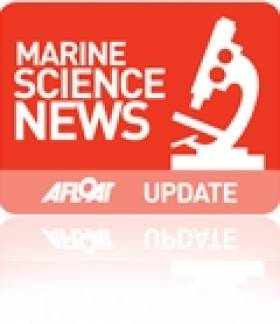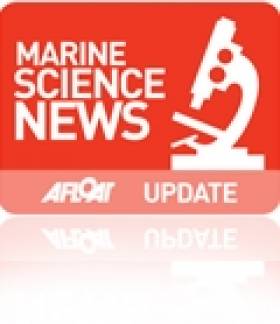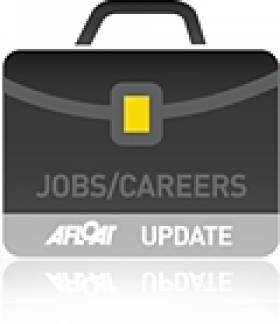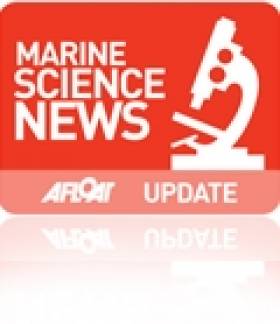Displaying items by tag: Marine Institute
Marine Institute Bursary Programme Highlighted
#marinescience – Twenty-two 3rd level students highlighted the value of the Marine Institute bursary programme at the annual Bursar Seminar day recently (24th July) where they show cased their skills and experience gained at the Institute.
The Marine Institute Bursary programme this year provided work experience for students from seven different third level Institutes and universities across Ireland, in a range of areas including: fish and shellfish assessments and surveys, corporate communications, sampling salmon and commercial fisheries in ports, assessments of maritime economics and oceanographic technology development.
Speaking about the value of the Marine Institute Bursary Programme, Dr Peter Heffernan, CEO of the Marine Institute, said "this year the students have clearly demonstrated their understanding and skills developed over the summer and am confident that this group of marine scientists will continue to ensure Ireland retains its high reputation in developing a strong marine sector.
It is encouraging to also see the students understand the value of engaging and promoting their work and the marine through story-telling and the use of imagery when giving presentations. Developing these skills will help foster a deeper understanding of the value of the marine."
Bursary students came from the following third level institutes: NUI Galway, Dublin City University, Dundalk Institute of Technology, University College Cork, Sligo Institute of Technology, Institute of Technology Tralee, Galway-Mayo Institute of Technology.
Marine Scientists Make New Discoveries on the Rockall Bank
#marinescience – A team of thirteen marine scientists representing eight nationalities led by Dr Aggeliki Georgiopoulou from University College Dublin (School of Geological Sciences) and Dr Veerle Huvenne from the National Oceanography Centre, UK (Marine Geoscience), recently completed a two week (15th – 26 July) expedition on the RV Celtic Explorer, where they made new discoveries relating to the geology and biological habitats of the south-eastern slope of Rockall Bank.
In the North Atlantic, 270 nautical miles (520 km) away from the Irish coast, the team used the remotely operated vehicle ROV Holland I and the Marine Institute's new six metre gravity corer to gain an unprecedented look at landslide scarps of the Rockall Bank Slide Complex, as well as determine the connection between the biology, terrain characteristics and the geology of the area.
The creation of this series of deep-sea escarpments, related to the Rockall Bank Slide Complex, is believed to have taken place after the last ice age, around 15,000 years ago. "During the expedition we discovered that the scarps in this area are actually very different from one another both geologically and biologically, which we hadn't anticipated as they are in such close proximity to one another," says Dr Aggeliki Georgiopoulou.
With fifty rock samples and over twenty gravity cores retrieved, the team hope to be able to explain this diversity. "We now need to further review the samples and data to help answer questions such as: do these differences in the terrain mean that this wasn't one single landslide? Could these escarpments have formed in different episodes and that's why they look so different? This is the first time we took such a close look at a submarine landslide so it will take us some time to analyse the video and relate what we see to what we know – this is completely new information for us. The video footage has also revealed that seafloor pinnacles evident on the Irish National Seabed Survey map are in fact volcanic edifices, so far not documented or included in the geological maps of the Irish offshore," explained Dr Georgiopoulou.
The importance of this research lies in the fact that it helps scientists compare and understand the geologic behaviour of sediments and rock on slopes under the sea and hence establish a better understanding of the stability of our continental slope.
"The use of the new gravity corer provided scientists with an opportunity to retrieve three metre core sediments from areas under the seabed that haven't been reached before. Also capturing footage and taking samples using the Holland I gave us an unprecedented look at the terrain. It was as if we were in the field itself, walking around and selecting exactly the samples we needed, instead of taking a blind hit in 1000 m water depth. Now we know exactly where each of our rock samples, short cores and biological samples came from," said Dr Veerle Huvenne.
"The faulting or fracturing of the earth's surface under the sea is not as rare as people might think, but because it is not visible it is often not considered. The research of the scarps in this area will provide us with key information on the possibility of future land-slides in this region. As this particular slope is facing Ireland, if there were a new landslide to occur, we need to estimate if it would impact the Irish west coast," said Dr Georgiopoulou.
A second aim of the expedition was to collect material that will contribute to the mapping of Ireland's marine habitats, which is important for marine spatial planning, particularly in the context of the increasing use of deep-sea resources.
"Habitat mapping efforts so far have been unable to accurately represent areas of steep and near-vertical slopes, due to the limitations of the traditional techniques used. Traditionally, instruments only visualise and sample material straight down, directly below the ship, so vertical habitats are overlooked even though recent studies are showing they can be very rich," explained Dr Veerle Huvenne.
Using the ROV Holland I the team of scientists retrieved nearly 50 hours of seabed video footage and up to 60 biological samples for taxonomic identification and DNA analysis. "We also used a portable multi-beam echo-sounder, but deployed it in a totally novel configuration, that I have only tested twice before on the UK ROV Isis. Normally a multi-beam system looks downward under a research vessel and sweeps the seafloor in stripes that are collated to make a seafloor map. We however positioned the multi-beam on the front of the ROV Holland I, looking forward and sweeping the vertical cliffs, creating essentially maps of walls," Dr Huvenne further said.
Aodhán FitzGerald, the Marine Institute Research Vessel Program Coordinator thanked the ROV engineers and pilots and vessel crew and technicians for their successful configuration and deployment of the ROV, corer and other equipment, which enabled optimal sample and data acquisition.
Dr Peter Heffernan, CEO of the Marine Institute congratulated the team of scientists, highlighting the importance of using innovative new methodology and technology during the expedition saying, "this expedition is a further example of the importance of cooperation between universities, institutes and countries in researching our ocean and increasing our knowledge of its dynamic systems."
Activities during the expedition are documented on the Marine Institute blog: scientistsatsea.blogspot.ie
This research survey CE14011 SORBEH is supported by the Marine Institute, and is funded under the Marine Research Sub-Programme by the Irish Government with a contribution from the ERC CODEMAP project.
#fish – Deep sea fish remove and store more than one million tonnes of CO2 from UK and Irish surface waters every year, according to a new study completed by researchers from the Marine Institute and the University of Southampton, UK.
It has been commonly thought that the ecosystem of deep water fish such as orange roughy, grenadiers and smoothheads depend on particles that fall from the surface waters for their food source. These bottom living deep water fishes never come to the surface and the carbon in their bodies therefore stays at the seafloor.
The team of researchers from the University of Southampton and the Marine Institute collected samples of fish on the continental slope west of Ireland, at water depths ranging from 500 to 1800m, during the deepwater research surveys on the Marine Institute's research vessel RV Celtic Explorer.
Using novel biochemical tracers to piece together the diets of deep-water fish revealed their role in transferring carbon to the ocean depths. "It was previously thought that these deepwater fish depended on "marine snow", organic particles falling from the surface, for their energy. We now however know that a huge volume of animals make daily vertical migrations from the mid-slope depths to feed at the surface during the night. The animals conducting this migration, then transport nutrients from the surface back to the deep," explained Graham Johnston, Marine Institute.
The researchers measured forms, or isotopes, of carbon and nitrogen, in the muscles of fish caught. Small differences found in the mass of these isotopes mean that they are processed at slightly different speeds in the body of the fish, leading to patterns which can show who eats who in the slope ecosystem. By measuring the isotopes in all of the most common species, the researchers were able to estimate how much carbon is captured and stored by these deep water fish. The marine scientists found that more than half of all the fishes living on the seafloor get their energy from animals that otherwise go back to the surface, and not from settling particles, as originally thought.
These bottom-living fishes therefore become a carbon capture and storage facility. Global peaks in abundance and biomass of animals at mid slope depths occur because this is the depth range where the vertically migrating animals are most easily captured by fishes that live at or near the seafloor.
Fish living in deep waters on the continental slope therefore play an important role carrying carbon from the surface to the seafloor. "This natural carbon capture and storage scheme could store carbon equivalent to £10 million per year in carbon credits," said lead author, Dr Clive Trueman from the University of Southampton.
"As fishing, energy extraction and mining extend into deeper waters, these unfamiliar and seldom seen fish in fact provide a valuable service to all of us. Recognising and valuing these ecosystems is important when decisions are made in relation to exploiting deep water habitats for food, energy or other mineral resources."
Dr Peter Heffernan, CEO of the Marine Institute congratulated the teams involved in this research highlighting the importance of such collaborations of research in Irish and UK waters. "Through this research, both the University of Southamption and the Marine Institute continue to promote the sustainable development of our oceans resource, while maintaining a healthy ecosystem".
The study, Trophic interactions of fish communities at midwater depths enhance long-term carbon storage and benthic production on continental slopes, by C. N. Trueman, G. Johnston, B. O'Hea, and K. M. MacKenzie (2014) is published in the journal Proceedings of the Royal Society B, and was funded by the University of Southampton and the Marine Institute.
#multibeam – A new multibeam sonar system fitted to the Marine Institute's Research Vessel Celtic Voyager will allow a new level of detail of seabed features to be captured during important mapping surveys around our coast.
It will greatly increase the capability of the vessel to acquire seabed bathymetry data as part of the INFOMAR seabed mapping program and other projects.
See how the new sonar operates in the promo vid below.
The new EM2040 system will be the primary mapping tool during upcoming INFOMAR survey operations offshore County Galway, Clare, and West Cork, extending the Irish seabed coverage around our coast.
This seabed mapping activity will support ocean energy development and fisheries management, and provide improved navigation for safe shipping and transport.
It was successfully installed onboard the RV Celtic Voyager during a recent dry docking in Killybegs, Co. Donegal.
The EM2040 system which was purchased from Kongsberg Maritime was installed on the vessel at the Department of Marine shipyard in Killybegs by P&O Maritime with the assistance of Mooney Boats of Killybegs.
This system replaces an older system which has been in use since 2000.
EurOCEAN 2014 during Italian-EU Presidency Conference
#EurOCEAN – CEO of the Marine Institute, Dr Peter Heffernan yesterday welcomed the announcement of the EurOCEAN 2014 Conference in Rome recalling the very successful EurOCEAN 2004 Galway Conference and the 2004 Galway Declaration on Marine Science & Technology.
The Galway Declaration, and subsequent EurOCEAN Conference Declarations (Aberdeen, 2007 and Ostend, 2010), have made significant contributions to the EU's Marine Research Agenda and the Integrated Maritime Policy for the European Union (2007). He looked forward to an equally influential Declaration from the Rome Conference.
EurOCEAN 2014 (7th – 9th October 2014, Rome) will bring together marine scientists across the broad range of disciplines with policymakers, industry and NGOs, to develop a common vision on achieving an ecosystem approach to the management of Europe's marine resources as a fundamental requirement for sustainable Blue Growth. Highlighting the importance of Blue Growth and of commercially-driven, problem-oriented research, EurOCEAN 2014 will equally emphasize that a growing and sustainable maritime economy will also require a much greater knowledge and understanding of marine ecosystem functioning and resilience.
For 2.5 days EurOCEAN 2014 cover a combination of plenary sessions and parallel workshops, organized around societal, policy and regional challenges. The conference programme will reflect the high-level messages of the European Marine Board's Navigating the Future-IV Foresight Report.
The EurOCEAN 2014 conference is part of the successful EurOCEAN Conference Series initiated in late 1990s to provide a regular focal point for the marine and maritime research community and stakeholders to interact with European and member state policymakers and programme managers, to discuss and respond to new marine science and technology developments, challenges and opportunities.
EurOCEAN 2014 is an official event of the Italian EU Presidency and is co-organized by the European Marine Board, European Commission and the Italian EMB members, CNRS, OGS and CoNISMA.
For further information see: http://eurocean2014.eu/
#oceanology – The Marine Institute is at Oceanology International 2014 in London this week (11-13 March) promoting Ireland's fast growing marine technology sector and highlighting the opportunities to do business in Ireland.
Ireland's SmartOcean Pavilion (stand B500) sponsored by the Marine Institute showcases a range of products and services, such as smart control technologies for subsea remotely operated vehicles; subsea power cable fault finding; innovative data buoy and anti-fouling wiper equipment; and adjustable 'clutch fins' technology that can potentially double the output of wave energy devices.
Exhibitors at the Ireland Pavilion represent Ireland's growing SmartOcean cluster with displays by Mobile and Marine Robotics Research Centre (UL), SmartBay Ireland, Geomara, Jospa, IDS Monitoring, as well as INFOMAR (the Irish strategic National Seabed Survey by the Geological Survey of Ireland and Marine Institute), and Research Vessel Operations at the Marine Institute.
Dr. Peter Heffernan, CEO, Marine Institute said:
"We're delighted to take part in Oceanology International 2014 alongside some of Ireland's marine technology innovators. Ireland is a great place to do marine business right now, with a growing number of high tech marine and ocean energy companies developing novel products and services for international markets. And together with our national marine test-bed infrastructure in Galway Bay, Ireland is an ideal location to test and validate marine energy and subsea technologies."
The Marine Institute continues to develop Ireland's national marine test and validation facility for marine energy and subsea technologies in Galway Bay. The subsea observatory will include a standard telecommunications cable to provide power and high speed data communication between the shore station and a network of subsea data ports and surface buoys at the test site. The project is a national collaboration between the Marine Institute, SmartBay Ireland, Sustainable Energy Authority of Ireland and Hydraulics and Maritime Research Centre (UCC).
At OI2014, SmartBay Ireland is actively seeking companies with technology prototypes who wish to use this facility to test and validate novel sensors and equipment, for example Wave Energy Converters, Subsea Sensors, Data and Communications systems.
Visit us at the Ireland Pavilion to explore opportunities emerging through local and international initiatives such as Horizon 2020. Ireland is well positioned to work with Atlantic partners in the sustainable development of our ocean resource.
Ireland's SmartOcean Pavilion at OI14 supports the achievement of key actions from the Governments Integrated Marine Plan, Harnessing Our Ocean Wealth. A Development Task Force was set up last December, appointed by Minister Simon Coveney to progress these actions including: promoting Ireland as a good place to do marine business and supporting new and existing marine test and demonstration facilities.
Student Bursars Wanted for Work Experience Programme
#jobs – The Marine Institute is inviting students to apply for a number of work experience placements in many exciting areas for this summer 2014. The bursaries are worth €2,200 each for an eight week placement based in various locations including the Marine Institute, Oranmore, Co. Galway, Newport, Co. Mayo and Harcourt Street, Dublin and ports around the country.
The Marine Institute's Bursary Programme provides valuable practical experience for students, in areas of research such Marine Fisheries, Salmon Management, Aquaculture, Environment, Communications, Oceanography, Maritime Development and our EU Desk.
The Bursary Programme is aimed at undergraduates of Universities, Institutes of Technology and National Institutes for Higher Education. The Scheme is strictly limited to undergraduates who have completed two years study in a relevant discipline. Previous bursars have gone on to work in the Marine Institute (including two Directors of the Institute), BIM, Regional Fisheries Boards, county councils, pharmaceutical companies, State Laboratories, with some going as far afield as the EPA in Sydney Australia and some now running their own companies.
To Apply for the Summer Bursary Programme:
o Please check out the bursary titles on offer
o Select the two bursaries that interest you most and in order of preference
o Complete the Application Form and return it FAO Annette Jordan, Marine Institute, Furnace, Newport, Co Mayo
o Application Deadline Date is 7th February 2014
Irish Maritime Development Office Seeks Director
#marinejobs – The Marine Institute is seeking to employ a Director for the Irish Maritime Development Office (IMDO). A member of the senior management team, the Director will lead a small team providing a wide range of services both to the public and private sector, such as business development, policy support, market intelligence, education and contributing to the formulation of sectoral strategies. A key deliverable is the provision of reports and advice to the Department of Transport, Tourism and Sport, including the quarterly Transport Economist.
The Director will be primarily responsible for managing the process of innovation and strategy to support the continuous growth and development of the shipping services sector in Ireland. They will be engaged at a high level supporting development with maritime companies and organisations in Ireland while working with major international shipping groups and shipping lines already doing business in Ireland.
The successful candidate will work closely with government departments, external parties and key stakeholders, providing market intelligence and critical inputs to policy advice or future development and support
To be successful, the candidate will have a minimum of ten years direct experience in the national and international shipping sectors, ideally in the areas of ship management, ship broking, finance or maritime economics. The candidate will also have a relevant degree or equivalent professional qualification and experience. The candidate will have successfully managed programmes, people and resources at a senior and strategic level and been involved in communicating and building relationships with stakeholders.
A detailed job description can be downloaded from the current vacancies section of our website at www.marine.ie.
If you meet all of our requirements, we would be delighted to hear from you. Please send your letter of application and an up to date CV to Catherine Johnston, Human Resources Manager, Marine Institute, Rinville, Oranmore, Co Galway or email to [email protected]. Please note email applications will only be accepted at this address and applications are not valid until you have received confirmation of your application.
The closing date for receipt of applications is 17:00 on Tuesday 7th January 2014. Late applications will not be accepted.
The Marine Institute is an equal opportunities employer.
Farmed Fish Shows Compliance Says Government Body
#fishfarm – Residues levels in farmed finfish as monitored by the Marine Institute in accordance with the National Residue Control Plan (NRCP) showed no non-compliant results in 2012 for the seventh year running according to a Marine Institute statement.
The Department of Agriculture, Food and the Marine have now released the results of testing of food of animal origin carried out under the National Residue Control Plan for 2012.
The NCRP, which was approved by the European Commission, is an important component of the Department's food safety controls and is implemented under a service contract with the Food Safety Authority of Ireland.
Since 1999 The Marine Institute has implemented the National Residues Monitoring Programme for aquaculture. This is carried out on behalf of the Sea Fisheries Protection Authority (SFPA), which is the responsible organisation for residue controls on farmed finfish.
In 2012, in excess of 759 tests for 1,596 substance determinations were carried out on 169 samples of farmed finfish for a range of residues, including banned and unauthorised substances, various authorised veterinary treatments, and environmental contaminants. No non-compliant results were reported from the national monitoring programme for farmed finfish in 2012, continuing the welcome trend demonstrating an absence of residues over the last seven years.
More information on the residues programme can be found on the Marine Institute website and in the residues monitoring programme report Chemical Residue in Irish Farmed Finfish.
#marineinst – Marine Institute Bursary students seized the opportunity to showcase their talent and skills highlighting their experiences during their eight-week work placements with the Marine Institute at the annual Bursar Seminar day at the Institute recently (18th July 2013).
The Bursary programme at the Marine Institute provides 3rd level students with the skills and experience to further develop their careers within the marine sector. Twenty-six students from diverse fields of studies are gaining work experience in a variety of jobs including fish and shellfish assessments and surveys, corporate communications, sampling salmon and commercial fisheries in ports, assessments of maritime economics and oceanographic buoy development.
Mr. Joe Silke, Marine Environment and Food Safety Manager at the Marine Institute, spoke about the quality of the bursars work during their eight week placements and the confidence Ireland can have in the future of the marine industry. "The students have continued to demonstrate their understanding, and the overall context of the programmes within which they have worked. It is encouraging to see that we have a new cohort of highly motivated and engaged marine scientists coming through the third level system that will ensure Ireland retains its high reputation in marine science and technology into the coming decades".
The value of the Marine Institute Bursary Programme, historically is significant to the marine science sector explained Ms. Helen McCormick, Senior Laboratory Analyst at the Marine Institute. "The bursary programme has been ongoing since the 1960's and it gives students an opportunity to gain valuable experience within their chosen subject field. Previous bursars have gained various positions within the Marine Institute at all grades up to and including Director level."
"The Bursary Seminar Day is used to give students a chance to practice their presentations skills and provide information on their bursary to their peers. The standard of the presentations this year was extremely high and showed that during the short period of the student bursaries, they fully understood the subject matter and were able to communicate this to the audience," she added.
The Bursary programme is highly recognised and is aimed at undergraduates who have completed two years' study in a relevant discipline. This year bursars came from a total of twelve different third level institutes across Ireland and the UK including NUI Galway, NUI Maynooth, University of Ulster, Queen's University Belfast, Galway-Mayo Institute of Technology, Institute of Technology Tralee, University of Plymouth, Sligo Institute of Technology, Anglia Ruskin University, Dundalk Institute of Technology, University College Cork and Carlow Institute of Technology.


























